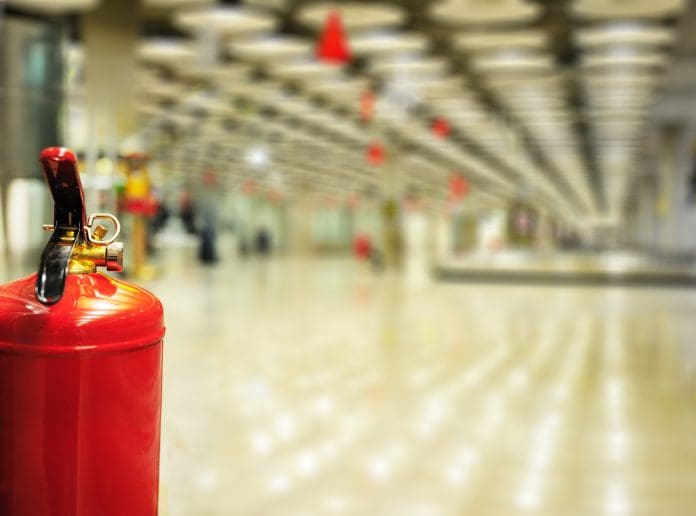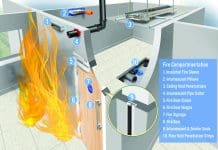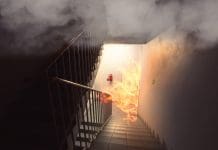Allan Wood, managing director of Optima Systems, examines where the commercial construction industry risks becoming complacent in fire safety compliance- and how to remedy this
In the fast-paced world of commercial construction, the industry often prides itself on meeting regulatory standards. But as the managing director of a commercial partitioning systems company, I feel a profound responsibility to address a concerning trend: we’re becoming complacent about fire safety. This complacency isn’t just a minor oversight—it’s a ticking time bomb.
The illusion of safety
On paper, buildings look safe. Manufacturers conduct fire tests, tick boxes, and hand out certificates. But here’s the uncomfortable truth: standardised tests often fail to reflect the complexities of real-world conditions. It’s like testing a car’s safety features in a controlled environment, then expecting it to perform the same way on a busy motorway during rush hour. The disconnect is stark and potentially dangerous.
Consider a typical office building. Installed fire doors may pass all the required tests. But what happens when those doors are paired with modern glass partitions, or part of an open-plan space with unique airflow patterns? Suddenly, conventional safety measures might not be as effective as people thought.
Enhancing industry fire safety knowledge
This problem is compounded by a widespread lack of understanding about fire safety principles. After all, it’s a complex field, and it’s natural not everyone is an expert. From architects to contractors and building managers, we all play crucial roles in ensuring safety.
By fostering a culture of continuous learning and open dialogue, we can enhance our collective understanding of fire safety principles. This isn’t about pointing fingers; it’s about empowering everyone to make more informed decisions.
I’ve sat in meetings where decision-makers have chosen materials or designs based solely on cost or aesthetics, without fully grasping the fire safety implications. It’s not that these professionals don’t care about safety—they simply haven’t been equipped with the knowledge to make truly informed decisions.
Taking a proactive approach to fire safety compliance in commercial spaces
So, how do we move forward and break this cycle? We might consider asking ourselves these questions:
- How can we adapt our testing methods to better reflect the diverse range of modern commercial spaces?
- Are there ways to make fire safety certifications more comprehensive and easier to understand?
- What additional resources or training could benefit our teams in making fire safety decisions?
These aren’t easy questions to answer, and addressing them might increase project costs. But consider the alternative: a tragedy that could have been prevented.
A collaborative future
Enhancing fire safety in commercial construction isn’t a task for any single company or professional. It requires a collaborative effort from across the industry. By working together, we can:
- Develop more nuanced testing protocols that better reflect real-world conditions
- Create accessible educational resources for ongoing professional development
- Encourage innovation in fire safety technologies and methodologies
The goal isn’t to overhaul current practices overnight, but to gradually and consistently improve our approach to fire safety.
Compliance is constantly evolving- and the industry should evolve with it
As we look to the future, let’s view fire safety not just as a set of standards to meet, but as an ongoing commitment to excellence. Every commercial building represents an opportunity to implement the best safety practices we can offer.
By fostering open dialogue, embracing continuous learning, and collaborating across different sectors of our industry, we can create a future where fire safety in commercial buildings is more robust and effective than ever before.
As industry leaders, we have a responsibility to drive this change. It’s not just about protecting property; it’s about safeguarding lives. Every person who walks into a commercial building should be able to do so with the confidence that their safety has been considered from every angle.




![[Video] Enhancing safety with fire doors: A case study of Marina Care Home](https://www.pbctoday.co.uk/news/wp-content/uploads/2025/06/maxresdefault-218x150.jpg)



![[VIDEO] Making DorTrak reports easy to read with Fireco Inspecting fire doors at Fireco, firedoor technology, 2023](https://www.pbctoday.co.uk/news/wp-content/uploads/2024/04/JPZ_2364-web-218x150.jpg)





![[VIDEO]What to expect when you’re inspecting: Using DorTrak for fire door inspections](https://www.pbctoday.co.uk/news/wp-content/uploads/2025/02/maxresdefault-218x150.jpg)